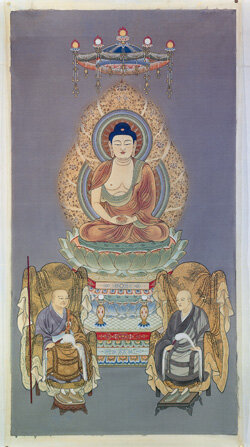Hi everyone.
Please forgive me as I am still very new but is there anything 'wrong' with how I practice? eg:
I have a small alter. It sits on the top of my bookcase (we have a cat, so you know how much they like to knock things over and this stops him.)
I have The Buddha central and up higher again on a small raised platform. On one side of the Buddha, I have a Jizo Bosatsu and a Kannon Bosatsu on the other. I use them to focus my thoughts on compassion, mercy, people far from me etc. To their outer sides, I have a candle that I light - so two in all - one on each side of my alter.
I will light the candles, ignite three sticks of incense from one of them and 'flick' the sticks to extinguish them. I will then, while standing, pay homage to the Buddha (Homage to the Blessed One, the Exalted One, the fully Enlightened One), bow three times and place the incense in a small holder before the Buddha.
I then 'kneel' using a homemade folding meditation stool, as it's the only way that I have found that stops my left leg from going numb and I recite The Heart Sutra.
I set a timer app that sounds like a rin bowl and I practice zazen by turning myself and my stool 90 degrees left and face the wall. After completing zazen, I turn back, facing the Buddha and still kneeling, I recite the Four Vows and then the Verse of Atonement.
(Once a week, following the above, I recite the Metta Chant.)
I'll sit in calmness for a short time, usually looking up and contemplating the Buddha, before bowing three times from my kneeling position, again paying homage and then fold up my stool, wrap it up and place it aside in a spot next to my bookshelf.
I leave the incense to finish burning and then cover the candles to put them out. I bow once more, facing the Buddha and generally leave by turning right, into my loungeroom, where my shoes are waiting for me.
This is my own ritual. I don't see it as 'wrong' as I'm doing it in good conscience and I don't think the Buddha would be offended but because I'm not 100% sure, this is why I'm posting this. It felt right to do it now. Any thoughts and advice are gratefully accepted, my friends.
I will not lie and said that I have sat today. I have not.
Gassho.
Rob.
Please forgive me as I am still very new but is there anything 'wrong' with how I practice? eg:
I have a small alter. It sits on the top of my bookcase (we have a cat, so you know how much they like to knock things over and this stops him.)
I have The Buddha central and up higher again on a small raised platform. On one side of the Buddha, I have a Jizo Bosatsu and a Kannon Bosatsu on the other. I use them to focus my thoughts on compassion, mercy, people far from me etc. To their outer sides, I have a candle that I light - so two in all - one on each side of my alter.
I will light the candles, ignite three sticks of incense from one of them and 'flick' the sticks to extinguish them. I will then, while standing, pay homage to the Buddha (Homage to the Blessed One, the Exalted One, the fully Enlightened One), bow three times and place the incense in a small holder before the Buddha.
I then 'kneel' using a homemade folding meditation stool, as it's the only way that I have found that stops my left leg from going numb and I recite The Heart Sutra.
I set a timer app that sounds like a rin bowl and I practice zazen by turning myself and my stool 90 degrees left and face the wall. After completing zazen, I turn back, facing the Buddha and still kneeling, I recite the Four Vows and then the Verse of Atonement.
(Once a week, following the above, I recite the Metta Chant.)
I'll sit in calmness for a short time, usually looking up and contemplating the Buddha, before bowing three times from my kneeling position, again paying homage and then fold up my stool, wrap it up and place it aside in a spot next to my bookshelf.
I leave the incense to finish burning and then cover the candles to put them out. I bow once more, facing the Buddha and generally leave by turning right, into my loungeroom, where my shoes are waiting for me.
This is my own ritual. I don't see it as 'wrong' as I'm doing it in good conscience and I don't think the Buddha would be offended but because I'm not 100% sure, this is why I'm posting this. It felt right to do it now. Any thoughts and advice are gratefully accepted, my friends.
I will not lie and said that I have sat today. I have not.
Gassho.
Rob.

 No idea how long
No idea how long 

 )
)




Comment